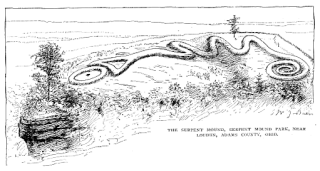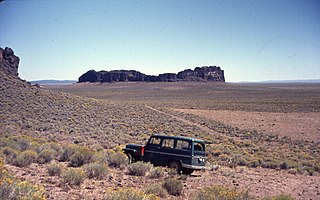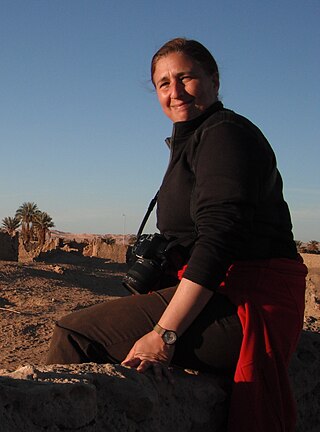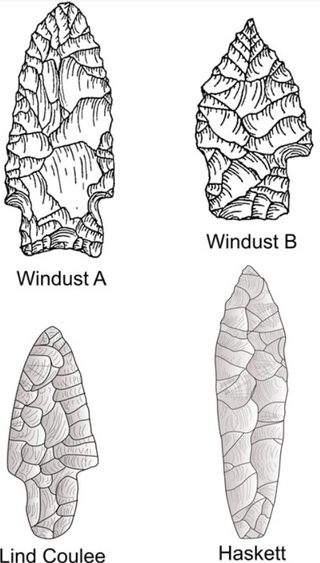Related Research Articles

A coprolite is fossilized feces. Coprolites are classified as trace fossils as opposed to body fossils, as they give evidence for the animal's behaviour rather than morphology. The name is derived from the Greek words κόπρος and λίθος. They were first described by William Buckland in 1829. Before this, they were known as "fossil fir cones" and "bezoar stones". They serve a valuable purpose in paleontology because they provide direct evidence of the predation and diet of extinct organisms. Coprolites may range in size from a few millimetres to over 60 centimetres.

In the sequence of cultural stages first proposed for the archaeology of the Americas by Gordon Willey and Philip Phillips in 1958, the Lithic stage was the earliest period of human occupation in the Americas, as post-glacial hunter gatherers spread through the Americas. The stage derived its name from the first appearance of Lithic flaked stone tools. The term Paleo-Indian is an alternative, generally indicating much the same period.

Lake Abert is a large, shallow, alkali lake in Lake County, Oregon, United States. It is approximately 15 mi (24 km) long and 7 mi (11 km) wide at its widest point. It is located 3 mi (4.8 km) northeast of the small, unincorporated community of Valley Falls, Oregon. The lake was named in honor of Colonel John James Abert by explorer John C. Fremont during his 1843 expedition into Central Oregon. No fish live in the alkaline waters of the lake; however, its dense population of brine shrimp supports a variety of shorebirds. The lake is an important stop on the bird migration route known as the Pacific flyway.
The Fremont-Winema National Forest of south central Oregon is a mountainous region with a rich geological, ecological, archaeological, and historical history. Founded in 1908, the Fremont National Forest was originally protected as the Goose Lake Forest Reserve in 1906. The name was soon changed to Fremont National Forest, named after John C. Frémont, who explored the area for the United States Army Corps of Engineers in 1843. It absorbed part of Paulina National Forest on July 19, 1915. In 2002, it was administratively combined with the Winema National Forest as the Fremont–Winema National Forests.

Fort Rock Cave was the site of the earliest evidence of human habitation in the US state of Oregon before the excavation of the Paisley Caves. Fort Rock Cave featured numerous well-preserved sagebrush sandals, ranging from 9,000 to 13,000 years old. The cave is located approximately 1.5 miles (2.4 km) west of Fort Rock near Fort Rock State Natural Area in Lake County. Fort Rock Cave was declared a National Historic Landmark in 1961, and added to the National Register of Historic Places in 1966.

Fort Rock–Christmas Lake Valley is a basin of a former inland sea that existed in that region from Pliocene through late Pleistocene time.

The Paisley Caves or the Paisley Five Mile Point Caves complex is a system of eight caves in an arid, desolate region of south-central Oregon, United States north of the present-day city of Paisley, Oregon. The caves are located in the Summer Lake basin at 4,520 feet (1,380 m) elevation and face west, carved into a ridge of Miocene and Pliocene era basalts mixed with soft volcanic tuffs and breccias by Pleistocene-era waves from Summer Lake. One of the caves may contain archaeological evidence of the oldest definitively-dated human presence in North America. The site was first studied by Luther Cressman in the 1930s.

Eske Willerslev is a Danish evolutionary geneticist notable for his pioneering work in molecular anthropology, palaeontology, and ecology. He currently holds the Prince Philip Professorship in Ecology and Evolution at University of Cambridge, UK and the Lundbeck Foundation Professorship in Evolution at Copenhagen University, Denmark. He is director of the Centre of Excellence in GeoGenetics, a research associate at the Wellcome Trust Sanger Institute, and a professorial fellow at St John's College, Cambridge. Willerslev is a foreign associate of the National Academy of Sciences (US) and holds the Order of the Dannebrog issued by her Majesty Queen Margrethe II of Denmark in 2017.

The Windust Caves (45-FR-46) are a series of nine caves eroded into a basalt cliff on the north side of the lower Snake River in Franklin County, southeastern Washington. The caves were excavated from 1959 until 1961 by a crew led by Harvey S. Rice. The site contains cultural artifacts dating back over 10,000 years and is culturally associated with other sites in the Columbia Basin.
Lake Mojave is an ancient former lake fed by the Mojave River that, through the Holocene, occupied the Silver Lake and Soda Lake basins in the Mojave Desert of San Bernardino County, California. Its outlet may have ultimately emptied into the Colorado River north of Blythe.

Paleofeces are ancient human feces, often found as part of archaeological excavations or surveys. The term coprolite is often used interchangeably, although coprolite can also refer to fossilized animal feces. Intact feces of ancient people may be found in caves in arid climates and in other locations with suitable preservation conditions. They are studied to determine the diet and health of the people who produced them through the analysis of seeds, small bones, and parasite eggs found inside. The feces can contain information about the person excreting the material as well as information about the material itself. They can also be chemically analyzed for more in-depth information on the individual who excreted them, using lipid analysis and ancient DNA analysis. The success rate of usable DNA extraction is relatively high in paleofeces, making it more reliable than skeletal DNA retrieval.
The Centre for Geogenetics is a Danish Basic Research Centre of Excellence (Grundforskningscenter) which officially opened in September 2010. It is located at the Natural History Museum of Denmark, University of Copenhagen and financed by the Danish National Research Foundation.

Dr. Marta Mirazón Lahr is a palaeoanthropologist and Director of the Duckworth Laboratory at the University of Cambridge.

The Picture Rock Pass Petroglyphs Site is in northern Lake County, Oregon, United States. The site is located near the summit of Picture Rock Pass on land administered by the Bureau of Land Management. The designs were scraped into a basalt boulder by ancient Native Americans, probably between 7,500 and 12,000 years ago. No one knows the meaning of the petroglyph designs. Because of its unique archaeological and cultural significance, the Picture Rock Pass Petroglyph Site was listed on the National Register of Historic Places in 1975.
Elizabeth Warder Campbell was an American archeologist, notable for proposing a much earlier date for the presence of humans in the desert Southwest than was generally accepted. She worked with her husband William (Bill) Campbell and first proposed that artifacts found along the shores of Lake Mojave and other Pleistocene lakes and rivers of the desert West were contemporaneous with the presence of water. They showed that there were virtually no sites that were not associated with archaic water sources. They hypothesized that the geologic features associated with the artifacts could be used to date the period of human habitation. This is the first use of what has become known as environmental archaeology.
The Neopluvial was a phase of wetter and colder climate that occurred during the late Holocene in the Western United States. During the Neopluvial, water levels in a number of now-dry lakes and closed lakes such as the Great Salt Lake rose and vegetation changed in response to increased precipitation. The event was not exactly synchronous everywhere, with neopluvial lake-level rises occurring between 6,000 and 2,000 years ago. It is correlative to the Neoglacial period.

The peopling of the Americas began when Paleolithic hunter-gatherers (Paleo-Indians) entered North America from the North Asian Mammoth steppe via the Beringia land bridge, which had formed between northeastern Siberia and western Alaska due to the lowering of sea level during the Last Glacial Maximum. These populations expanded south of the Laurentide Ice Sheet and spread rapidly southward, occupying both North and South America by 12,000 to 14,000 years ago. The earliest populations in the Americas, before roughly 10,000 years ago, are known as Paleo-Indians. Indigenous peoples of the Americas have been linked to Siberian populations by proposed linguistic factors, the distribution of blood types, and in genetic composition as reflected by molecular data, such as DNA.

David Jeffrey Meltzer is an American archaeologist known for his influential studies of Paleo-Indians and Pleistocene mammalian extinction in the Americas. He is currently Henderson-Morrison Professor of Prehistory at Southern Methodist University and Affiliate Professor at the Centre for GeoGenetics at the University of Copenhagen.
The theory known as "Clovis First" was the predominant hypothesis among archaeologists in the second half of the 20th century to explain the peopling of the Americas. According to Clovis First, the people associated with the Clovis culture were the first inhabitants of the Americas. This hypothesis came to be challenged by ongoing studies that suggest pre-Clovis human occupation of the Americas. In 2011, following the excavation of an occupation site at Buttermilk Creek, Texas, a group of scientists identified the existence "of an occupation older than Clovis." At the site in Buttermilk, archaeologists discovered evidence of hunter-gatherer group living and the making of projectile spear points, blades, choppers, and other stone tools. The tools found were made from a local chert and could be dated back to as early as 15,000 years ago.

The Western Stemmed Tradition (WST) is a Paleoindian archaeological culture known from the Intermountain West of North America, particularly the Great Basin and the Columbian Plateau, spanning from over 13,000 years Before Present to around 8,500 years Before Present. Unlike Clovis and related traditions, the stone projectile points produced by the Western Stemmed Tradition are unfluted. Other types of tool produced by WST peoples include stone crescents. The Western Stemmed Tradition has a wide variability in tool morphology, and is divided up into a number of chronologically separated subtypes, including Haskett, Cougar Mountain, Lind Coulee Parman Silver Lake and Windust. Some of the oldest sites of the tradition are at Cooper's Ferry in Idaho and Paisley Cave in Oregon, dating to the Bølling–Allerød Interstadial, as early as 13,500 BP at Cooper’s Ferry. Pre-Clovis stemmed points are also known from the Debra L. Friedkin and Gault sites in Texas, perhaps dating as early as 14,500 BP, though these are outside the core distribution area of the WST.
References
- 1 2 3 Fried, Stephen (2010-06-13). "Who Were the First Americans?". Parade . Retrieved April 4, 2016.
- 1 2 3 4 5 6 7 "Dennis Leroy Jenkins Curriculum Vita" (PDF). University of Oregon. Archived from the original (PDF) on April 22, 2016. Retrieved April 9, 2016.
- 1 2 3 "Dennis Jenkins". Heritage Key. Archived from the original on July 27, 2011. Retrieved December 2, 2010.
- ↑ Gilbert, M. Thomas P.; Dennis L. Jenkins; et al. (April 3, 2008). "DNA from Pre-Clovis Human Coprolites in Oregon, North America". Science Express . 320 (5877): 786–9. Bibcode:2008Sci...320..786G. doi: 10.1126/science.1154116 . PMID 18388261. S2CID 17671309 . Retrieved December 2, 2010.